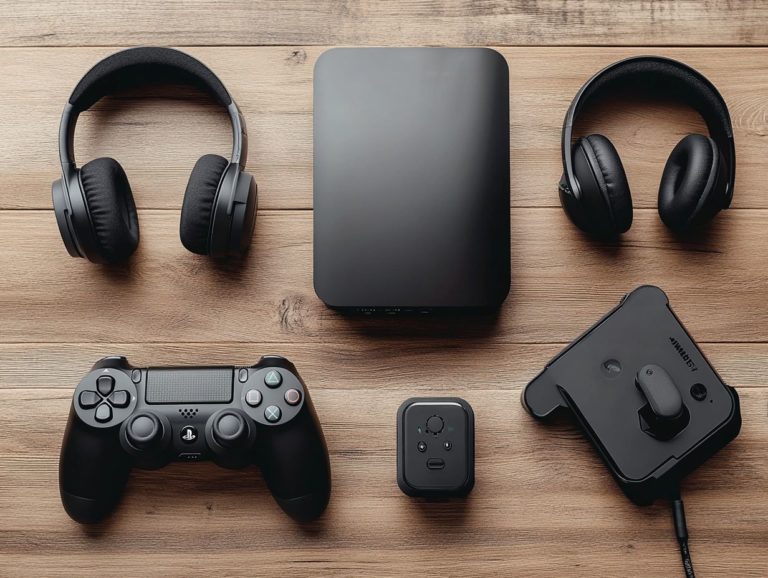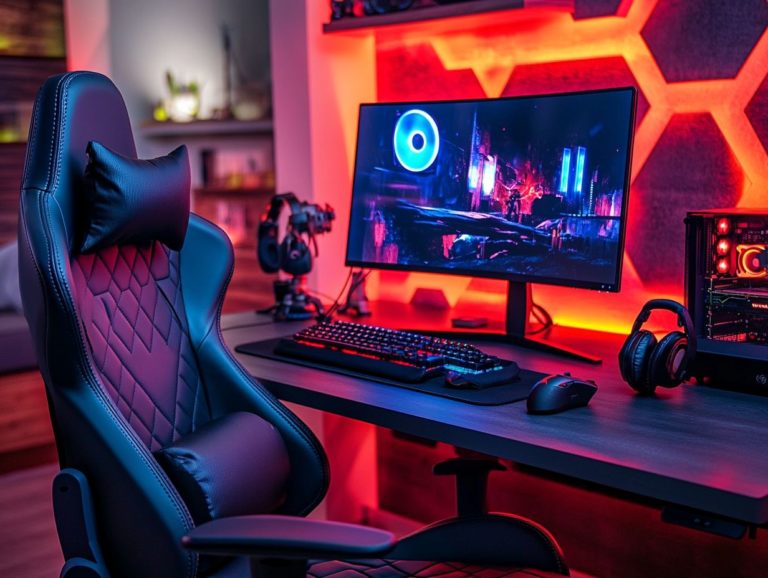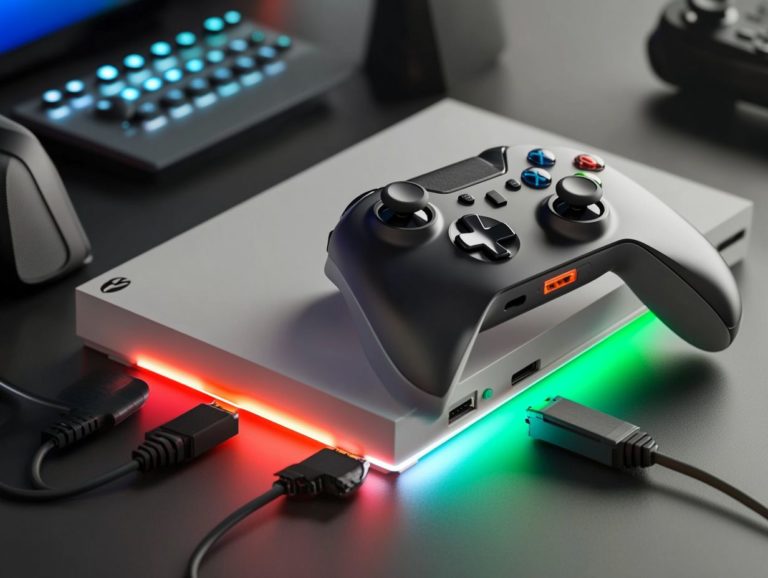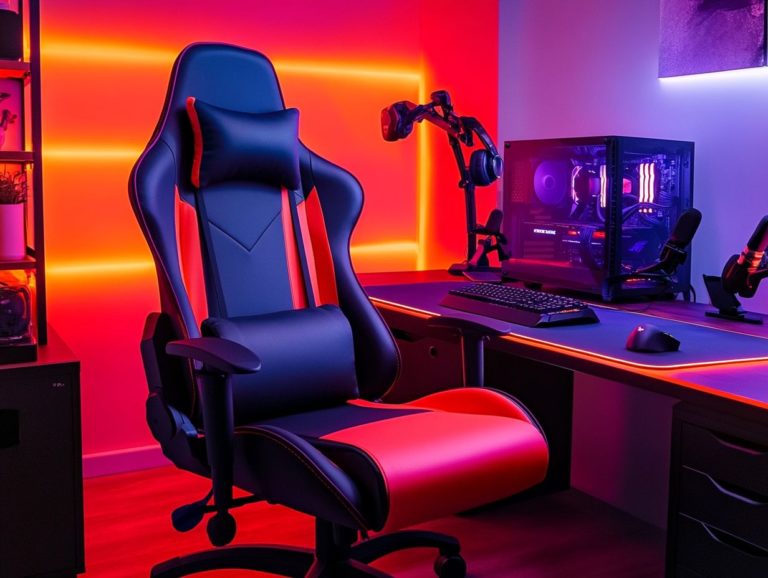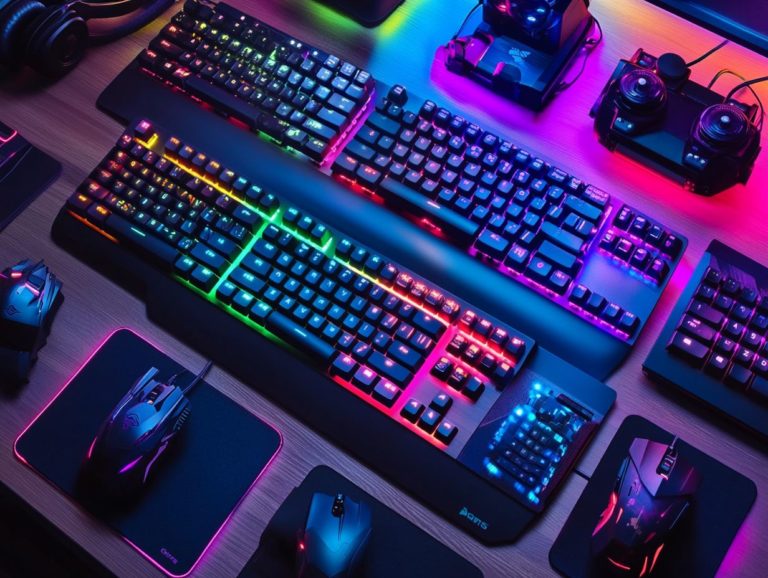how to test for input lag in gaming monitors?
In gaming, every millisecond counts. Input lag can make or break your experience. This article explores the details of input lag in gaming monitors, explaining its importance.
You will discover how to test input lag and what factors influence it. We ll also share effective strategies to minimize those annoying delays.
You will also find guidance on how to select the best gaming monitor. We highlight essential features and top recommendations. Get ready to transform your gaming experience!
Contents
- Key Takeaways:
- Understanding Input Lag in Gaming Monitors
- Methods for Testing Input Lag
- Factors that Affect Input Lag
- Minimizing Input Lag
- Choosing the Right Gaming Monitor
- Frequently Asked Questions
- What does input lag mean for your gaming experience?
- Why is it important to test for input lag in gaming monitors?
- How can I test for input lag in gaming monitors?
- Can I test for input lag on any gaming monitor?
- What is considered a good input lag for gaming monitors?
- Can I reduce input lag on my gaming monitor?
Key Takeaways:
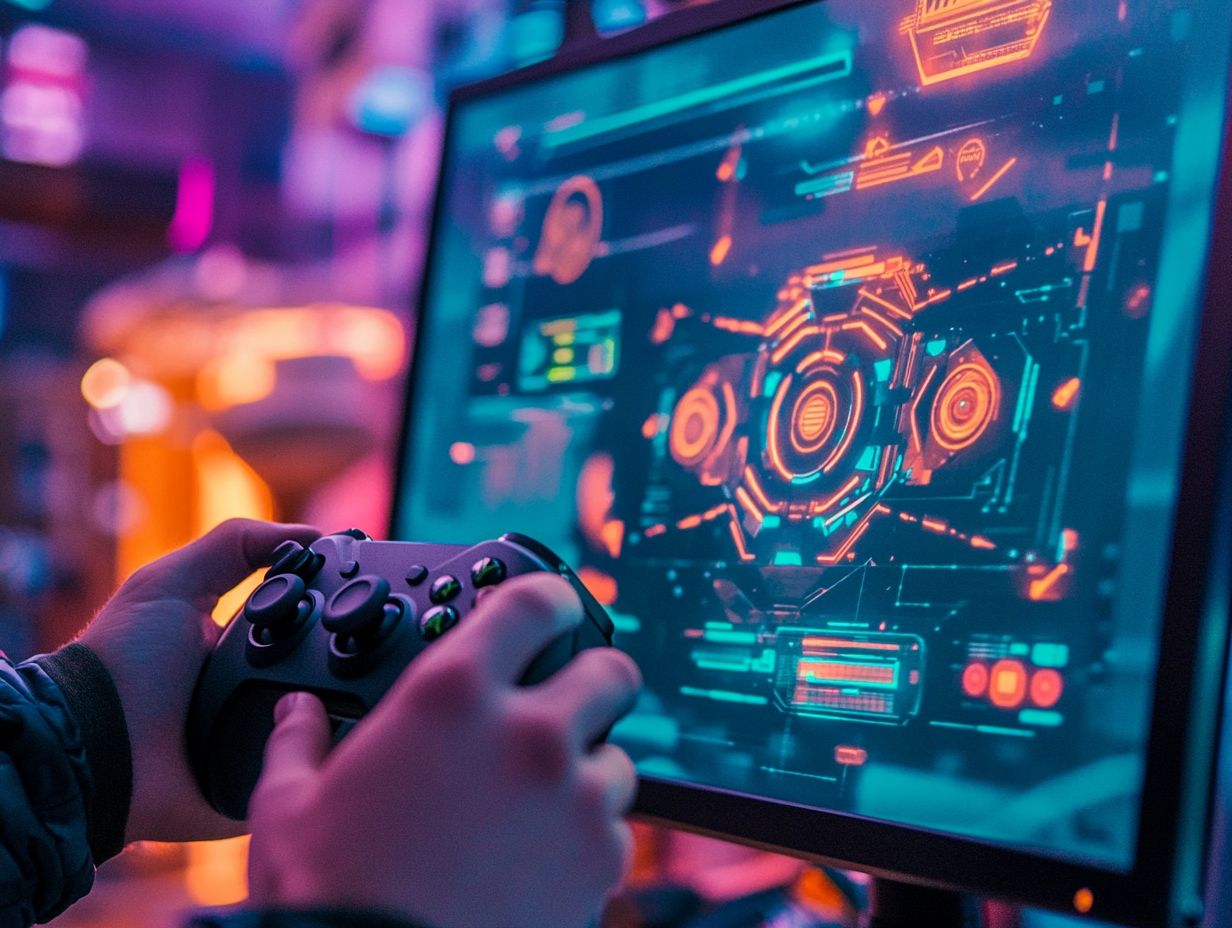
Input lag affects your monitor’s responsiveness and your overall gaming experience. You can test input lag manually with software or use external devices. Factors like hardware and optimization settings can influence this lag, making it crucial to choose a monitor with low input lag for optimal performance.
Understanding Input Lag in Gaming Monitors
Understanding input lag is essential for anyone seeking a competitive edge in fast-paced video games. Input lag is the delay between your action and the response on the screen. This delay can significantly impact your gaming experience.
This latency can come from various sources, including monitor response time, refresh rate (the speed at which your monitor updates the image), and the performance of your gaming hardware. Many gamers overlook these details, yet they are critical especially in competitive games where every millisecond matters.
By learning how to measure and reduce input lag, you can boost your performance and enjoyment of games.
What is Input Lag and Why is it Important?
Input lag is the delay between your input and the response on the screen. It plays a crucial role in shaping your gaming experience. High input lag can severely hurt your performance in competitive games where quick reflexes are vital.
This delay can manifest as display lag, controller lag, or processing lag, each affecting gameplay differently. In fast-paced shooters, even a fraction of a millisecond can mean the difference between hitting a critical shot or becoming an easy target.
In fighting games, timing is everything. A delayed move can lead to missed combos or failed counterattacks. Low latency is vital for competitive gamers; it ensures that your actions translate smoothly on-screen, enhancing performance and responsiveness.
Consider this: A gaming monitor with a 1ms response time can outperform one with 5ms, improving gameplay fluidity significantly.
Methods for Testing Input Lag
Testing input lag can be done in several ways, helping you understand the latency of your gaming systems and monitors for an optimal experience. Accurate tests are vital to pinpoint performance issues and determine if hardware upgrades are necessary.
Manual Testing with Software
Manual testing with software is an effective method to measure input lag on gaming monitors. With apps designed to analyze response time, you can uncover performance issues not visible during normal gameplay. For detailed instructions, check out how to test the performance of your gaming gear.
Among the tools available, piLagTester stands out for its user-friendly interface and thorough analysis. Simply connect the software to your gaming monitor and follow the prompts to evaluate latency across various scenarios.
Other tools, like MonitorTest and Lagom LCD test, also provide unique metrics and visual feedback. After testing, focus on the average input lag and response time variations. These insights will help you decide on necessary adjustments or upgrades.
With this information, you can ensure a smoother, more responsive gaming experience, effectively reducing the frustrating delays that can interrupt your gameplay.
Using External Devices
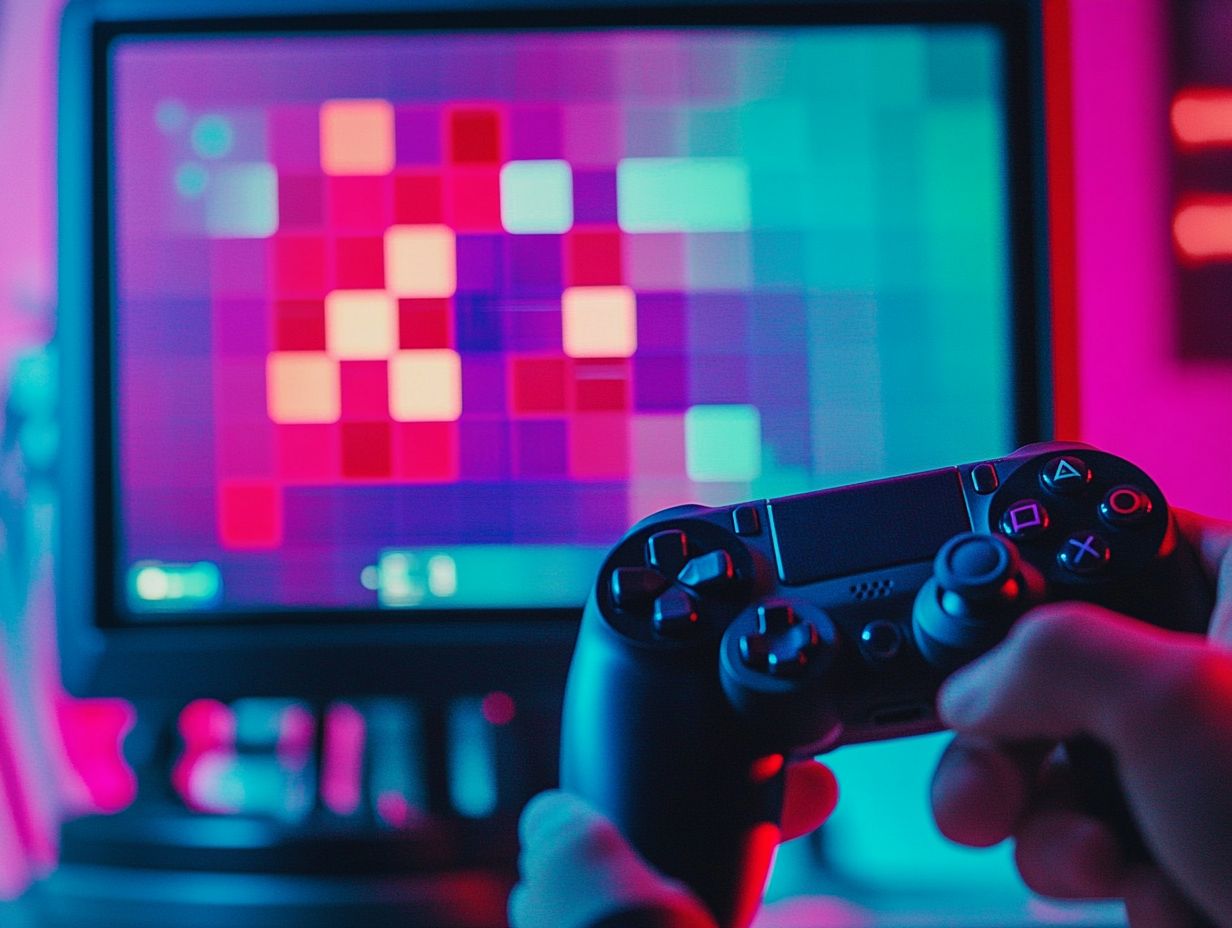
Using external devices for testing input lag gives you a precise measurement compared to relying solely on software. These tools capture the delay between your input and the display response with remarkable accuracy.
For instance, high-speed cameras can effectively measure latency issues that impact your gaming experience.
You also have access to specialized tools like the Leo Bodnar Input Lag Tester and the Display Lag Tester.
The Leo Bodnar device connects easily to your monitor, measuring input lag by comparing the time it takes for a test signal to be displayed. The Dell S2719DGF features a high refresh rate and low response time, making it an excellent choice for input lag measurements.
These devices not only tell you how responsive a gaming monitor is but also provide valuable insights for competitive play. This allows you to fine-tune your setup for optimal performance.
Factors that Affect Input Lag
Several factors contribute to input lag in gaming, each influencing performance and your experience uniquely.
It s important to understand factors such as hardware specifications, software configurations, and the characteristics of your connected peripherals to optimize your gaming system and minimize latency.
Grasping these intricacies can elevate your gameplay to new heights.
Hardware and Software Considerations
Hardware and software considerations are crucial in shaping input lag. Their harmony directly influences latency and your overall gaming experience.
By carefully selecting components and optimizing software settings, you can significantly enhance response times.
For example, choosing a high-end CPU and GPU minimizes processing delays, ensuring your commands are executed swiftly.
Monitors with technologies like G-Sync and FreeSync reduce tearing and stuttering, preventing frustrating interruptions during gameplay. Adjusting settings such as Vsync and refresh sync can also limit input lag, resulting in a smoother experience.
To maximize your performance, consider:
- Regularly updating your drivers
- Tweaking resolution settings for optimal frame rates
- Reducing graphic fidelity when necessary to balance visual quality and responsiveness.
Minimizing Input Lag
Minimizing input lag is crucial for serious gamers, especially those in competitive play.
Achieve this by optimizing settings and implementing thoughtful hardware upgrades. Addressing key factors that contribute to latency can significantly elevate your gaming performance and give you a competitive edge.
Optimizing Settings and Hardware
Optimizing your settings and hardware can greatly reduce input lag, leading to a smoother gaming experience. By adjusting key settings, you can achieve substantial performance improvements, especially in competitive games where every millisecond counts.
Consider tweaking the refresh rate and resolution of your display. A higher refresh rate, like 144Hz, enhances visual fluidity, making your movements feel almost instantaneous. Ensure your frame rate matches the monitor’s refresh rate to minimize stutter.
Upgrading your hardware, such as switching from USB 2.0 to USB 3.0 ports for your peripherals, decreases input lag due to faster data transfer speeds. Opting for HDMI or DisplayPort connections instead of older formats provides better signal quality and lower latency.
Alongside these adjustments, enable game mode in your display settings for optimal performance.
Choosing the Right Gaming Monitor
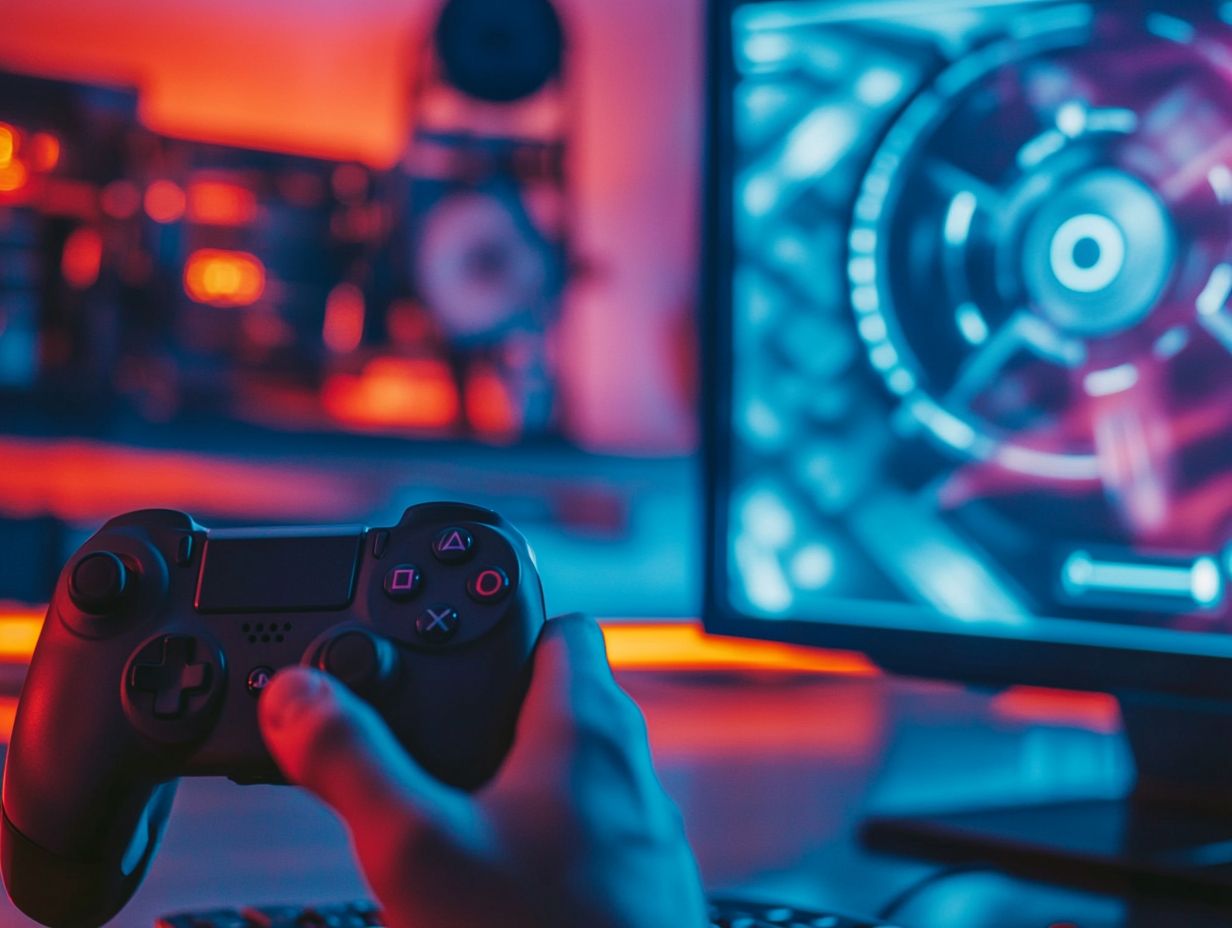
Selecting the right gaming monitor is essential for reducing input lag and achieving peak performance in competitive gaming.
The specifications of a monitor, including response time and refresh rate, play a vital role in influencing input lag. Gamers must understand these features thoroughly to enhance their gaming experience effectively.
Don t miss out on optimizing your setup! Experiment with your settings and try new hardware to see noticeable results.
Features to Look for in a Gaming Monitor
When selecting a gaming monitor, you’ll want to focus on several crucial features that can dramatically influence the delay in response and your overall gaming performance.
Key specifications such as response time and refresh rate are essential for elevating your gaming experience. Additionally, support for technologies like G-Sync and FreeSync helps prevent screen tearing, enhancing your gameplay fluidity and responsiveness.
A lower response time minimizes ghosting and blurring, which is vital in fast-paced action games. A higher refresh rate ensures that each frame transitions seamlessly, reducing stuttering and creating a more immersive experience.
Adaptive sync technologies synchronize the monitor’s refresh rate with your graphics card, effectively reducing screen tearing.
If you’re into competitive FPS titles, you need a monitor with at least a 144Hz refresh rate and a 1ms response time. You’ll discover that a 60Hz option is perfect for casual gaming!
Choose wisely, and unleash your gaming potential!
Top Picks for Low Input Lag Monitors
Regarding low input lag gaming monitors, some models truly shine with their exceptional performance and responsiveness. These monitors are engineered to minimize input lag, giving you the competitive edge you desire in fast-paced games.
With rapid refresh rates and advanced response times, these displays ensure that every move, shot, and strategic decision translates seamlessly into on-screen action no delays allowed. High-quality panels, particularly those featuring IPS technology, deliver quick responses and breathtaking visuals, enhancing your overall gaming immersion.
Look for features like G-Sync and FreeSync to eliminate screen tearing and stuttering, resulting in smoother gameplay.
By selecting the right low input lag monitor, you can significantly elevate your gaming experience, allowing you to outperform your competitors and fully savor your favorite titles.
Frequently Asked Questions
What does input lag mean for your gaming experience?
Input lag refers to the delay between pressing a button or moving a controller and seeing the corresponding action on the screen. This delay can significantly impact gameplay and overall performance.
Why is it important to test for input lag in gaming monitors?

Input lag impacts your gaming experience. It’s crucial to identify and fix any delays. Testing for input lag ensures smoother and more responsive gameplay.
How can I test for input lag in gaming monitors?
One of the simplest ways to test for input lag is by using dedicated software or websites that measure the delay between pressing a button and seeing the corresponding action on the screen. You can also perform a manual input lag test with a stopwatch and a high-speed camera.
Can I test for input lag on any gaming monitor?
Yes, input lag testing can be performed on any gaming monitor, regardless of the brand or model. However, the accuracy of the test results may vary depending on the monitor’s specifications and the testing method used.
What is considered a good input lag for gaming monitors?
A monitor with an input lag of less than 20ms is considered good for gaming. Competitive gamers may prefer a lower input lag of around 10ms for a more responsive gameplay experience.
Can I reduce input lag on my gaming monitor?
Yes, there are steps to help reduce input lag on gaming monitors. Disable post-processing effects, enable game mode or low latency mode, and use a wired controller or keyboard. Updating the monitor’s firmware and graphics card drivers can also improve input lag.

